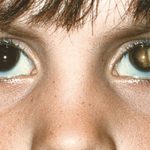 A malignant tumor in the retina.
A malignant tumor in the retina.
A rare tumour in the retina, affecting infants.
Retinoblastoma is a rare form of childhood cancer in which malignant tumor(s) originate in the retina of the eye. The majority (75%) of cases are unilateral retinoblastoma, in which tumors develop in one eye. Tumors that are found in both eyes are referred to as bilateral retinoblastoma.
A malignant tumor that often occurs in the eyes of very young children.
Congenital, hereditary neoplasm of retinal cells, the most common eye malignancy in childhood. Diminished vision, detached retina, and abnormal pupillary reflexes are common. Treatment includes removal of the eye.
A rare malignant tumor of the retina, occurring in infants.
A rare malignant growth of the retina which occurs in infants. It can sometimes be discovered at birth because shining a light in the baby’s pupil produces a white reflection rather than a red one. Alternatively, the infant may present with a squint. In 25 per cent of cases there is a family history of the condition and abnormality of chromosome 13 is common. It is treated by removing the eye or, if affecting both eyes, by laser photocoagulation with or without radiotherapy.
A malignant glioma of the retina, usually unilateral, that occurs in young children and usually is hereditary. One of hundreds of genetic mutations in a tumor regulatory protein (the retinoblastoma protein) may be responsible. The initial diagnostic finding is usually a yellow or white light reflex seen at the pupil (cat’s eye reflex). Several treatment options are available depending on the size and extent of the tumor, whether both eyes are involved, and the general health of the patient. Included are enucleation, radiation, scleral plaque irradiation, cryotherapy, photocoagulation, and chemotherapy.
An inherited cancerous growth originating in the retina, specifically found in children.
Retinoblastoma is a form of eye cancer that develops in the retina, the innermost light-sensitive layer at the rear of the eye. This condition primarily impacts infants. The initial signs of this ailment might include a crossed eye due to the impaired eye’s blindness or a noticeable whitish appearance within the pupil. If left untreated in its early stages, retinoblastoma has the potential to extend into the eye socket (orbit) and progress along the optic nerve, reaching the brain.
Retinoblastoma is rooted in genetics. Individuals afflicted by this cancer have a portion of one chromosome missing from pair number 13. Infants born into families with a history of this condition receive routine eye assessments, while potential parents within these families are encouraged to pursue genetic counseling.
The treatment options involve surgical removal of the impacted eye or the utilization of radiotherapy. In situations where both eyes are affected, the more severely affected eye might be surgically removed, while the other eye could receive radiotherapy.
